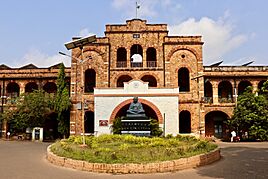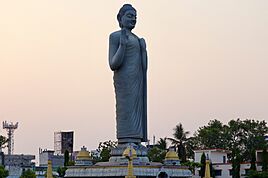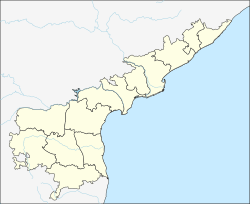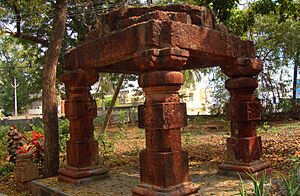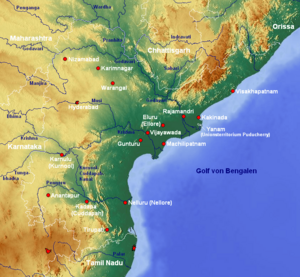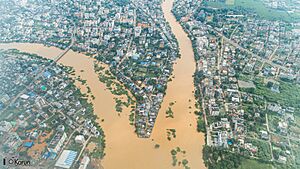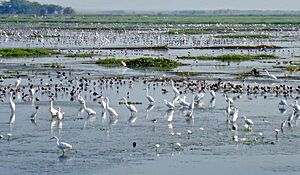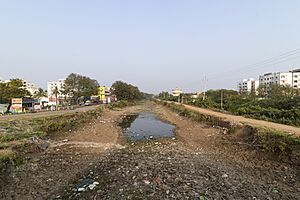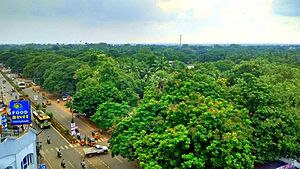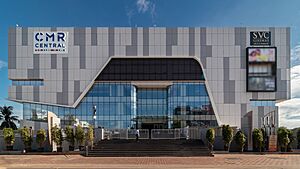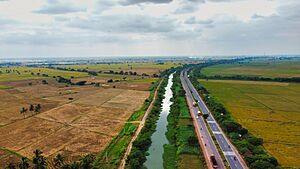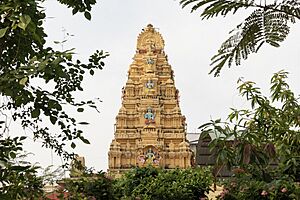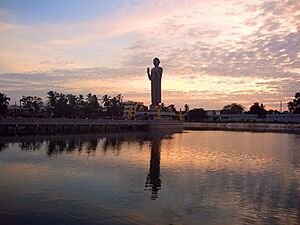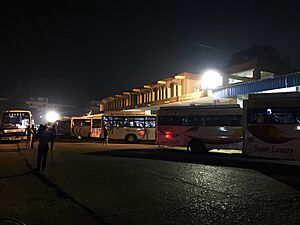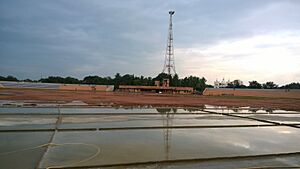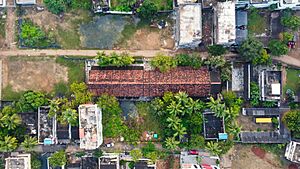Eluru facts for kids
Quick facts for kids
Eluru
Helapuri
|
|
|---|---|
|
Municipal Corporation
|
|
|
Clockwise from top: District Collectorate of Eluru district, Eluru railway station, Sunset at Kolleru Lake, Eluru Buddha Park, Gopuram of Sanivarapupeta temple ang NH16 near Eluru
|
|
| Motto(s):
Truth always Triumphs
|
|
| Country | |
| State | Andhra Pradesh |
| District | Eluru |
| Founded | 2nd century |
| Incorporated (town) | 1866 |
| Incorporated (city) | 9 April 2005 |
| Government | |
| • Type | Mayor–council |
| • Body | Eluru Municipal Corporation, ELUDA |
| Area | |
| • Municipal Corporation | 11.52 km2 (4.45 sq mi) |
| • Urban | 154 km2 (59 sq mi) |
| • Metro | 3,328.99 km2 (1,285.33 sq mi) |
| Elevation | 22 m (72 ft) |
| Population
(2011)
|
|
| • Municipal Corporation | 214,414 |
| • Rank | 12th (in state) |
| • Density | 18,612/km2 (48,206/sq mi) |
| • Metro | 2,760,160 |
| Demonym(s) | Elurian, Elurite, Helapuree |
| Languages | |
| • Official | Telugu |
| Time zone | UTC+5:30 (IST) |
| PIN |
534***
|
| Telephone code | +91–08812 |
| Vehicle registration | AP-39 |
Eluru (pronounced eh-loo-roo) is an important city in the Indian state of Andhra Pradesh. It is the main city and headquarters of Eluru district. Eluru is one of 14 major cities in Andhra Pradesh and is located on the banks of the Tammileru River. Long ago, it was known as Helapuri.
In 2011, the city had a population of over 214,000 people. Eluru has a long history, dating back to the 2nd century CE. It was an important town under different rulers like the Qutub Shahis and the Mughal Empire. Later, it became part of the British Madras Presidency.
In 2020, Eluru made headlines due to a mysterious illness that affected many people. The city is in the Krishna River Delta region, known for its rich farmland. Kolleru Lake, India's largest freshwater lake, is also very close by. Eluru is famous for its special pile carpets, and it's also a big trading center for fish, rice, and tobacco. The city is well-connected by roads and trains. It also has important schools and colleges, making it a center for learning.
Contents
History
How Eluru Got Its Name
Long ago, Eluru was part of the Vengi Kingdom and was called 'Helapuri'. It was also known as Erla Uru. When the British took over, they called it Ellore. To avoid confusion with another town called Vellore, Eluru was sometimes called Uppu Ellore (meaning Salt Ellore).
Early Times and Kingdoms
| Historical affiliations |
|
Eluru has a very old history, going back to the 2nd century CE. The area near Eluru, called Vengi, was the capital of Andhra for many centuries. Different kingdoms ruled from Vengi, including the Salankayanas, Vishnukundinas, and Eastern Chalukyas.
The Salankayanas ruled from the 3rd to the 5th century CE. They were known for their first king, Devavarman, who performed a special ceremony called the Ashvamedha sacrifice. This ceremony celebrated the start of his kingdom.
Later, the Vishnukundinas took over in the late 5th century. Eluru was an important city during their rule. After them, the Eastern Chalukyas ruled for about 500 years, from the 7th century to 1130 AD. Their capital was Vengi, near Eluru, before it moved to Rajahmundry.
Over the centuries, Eluru was also ruled by the Kakatiyas, the Kalinga Empire, and the Gajapatis. In 1515, King Srikrishnadevaraya captured it. Finally, around 1565 AD, it came under the Qutb Shahi dynasty and then the Mughal Empire in 1687.
Modern Times
In the 17th century, the British East India Company started to gain power in India. In 1689, they got permission to set up a trading post in Eluru. In 1724, the region became part of the Nizam of Hyderabad's kingdom.
Later, in 1753, the Nizam gave control of Eluru and other areas to the French East India Company. But the British and French were fighting for control of India. In 1759, British forces took over Eluru and other areas from the French. By 1766, the British officially controlled Eluru.
During British rule, Eluru became an important military base and the capital of the Northern Circars, a part of the Madras Presidency. The British divided the region into different districts over time. In 1925, Eluru became the headquarters of the West Godavari district. In 2022, Eluru district was formed, with Eluru as its main city.
India's Fight for Freedom
People in Eluru also played a part in India's fight for freedom. In 1894, farmers in the area protested against high water taxes. In 1921, Mahatma Gandhi visited Eluru to encourage people to join the freedom movement. He opened a special college there, the Gandhi Andhra Jateeya Mahavidyalayam, to promote education.
Leaders like N. G. Ranga helped set up socialist groups in Eluru to spread the idea of freedom. People in Eluru also supported the boycott of the Simon Commission in 1928, which was a British group visiting India. During Gandhi's individual Satyagraha in 1941, leaders like Venkata Raju visited Eluru to gather support.
Dalit Movement
The Dalit movement worked for the rights and equality of people who were considered "untouchable." In 1917, the First Andhra Desa Panchama Conference was held, and Bhagya Reddy Varma toured districts like Eluru to spread awareness. His efforts led the government to change the term "Panchama" to "Adi-Andhra" in 1922.
In 1944, Dr. B.R. Ambedkar, a very important leader for Dalit rights, visited Eluru. His speeches inspired many local people to stand up for themselves and work for social change.
Eluru Outbreak
On December 4, 2020, Eluru faced a health crisis. Many people suddenly developed strange symptoms like seizures and losing consciousness. Within three days, about 500 people were affected. Teams from the WHO and other experts came to investigate.
They collected blood, urine, water, and food samples. Tests showed that a pesticide called Triazofos was found in many blood and urine samples. It was also found in household drinking water. The experts concluded that this pesticide contamination was the likely cause of the outbreak. They recommended better checks on pesticides in soil, water, and food to prevent future problems.
Geography
Eluru is located about 22 meters (72 feet) above sea level. It is on the Eastern Coastal Plains, roughly halfway between the Krishna River and Godavari River. The city is about 50 kilometers (31 miles) from the Bay of Bengal.
The Tammileru River flows through Eluru and into Kolleru Lake. This lake is a large freshwater lake close to the city. Kolleru Lake is very important for farming and for the animals and birds living there. The Eluru Canal also runs through the city. It helps bring water from the Krishna River for irrigation, which means watering crops.
Kolleru Lake is the biggest freshwater lake between the Godavari and Krishna river deltas. It is a shallow lake, about 0.5 to 2.0 meters deep in summer. It covers about 245 square kilometers. Kolleru Lake is recognized internationally as an important wetland. It helps control floods and is a vital home for many birds, both local and those that migrate from far away.
Climate
Eluru has a hot and humid climate because it is close to the Bay of Bengal. The average yearly temperature is about 28.2°C (82.8°F). May is usually the hottest month, and December is the coolest. Temperatures can go above 40°C (104°F) in summer. July gets the most rain, and the city receives about 992 mm (39 inches) of rain each year.
| Climate data for Eluru, Andhra Pradesh | |||||||||||||
|---|---|---|---|---|---|---|---|---|---|---|---|---|---|
| Month | Jan | Feb | Mar | Apr | May | Jun | Jul | Aug | Sep | Oct | Nov | Dec | Year |
| Mean daily maximum °C (°F) | 29.1 (84.4) |
31.7 (89.1) |
34.5 (94.1) |
36.7 (98.1) |
38.6 (101.5) |
36.9 (98.4) |
32.4 (90.3) |
32.0 (89.6) |
32.2 (90.0) |
31.4 (88.5) |
29.8 (85.6) |
28.8 (83.8) |
32.8 (91.1) |
| Mean daily minimum °C (°F) | 18.9 (66.0) |
20.3 (68.5) |
22.6 (72.7) |
25.8 (78.4) |
27.9 (82.2) |
27.2 (81.0) |
25.4 (77.7) |
25.3 (77.5) |
25.3 (77.5) |
24.3 (75.7) |
21.3 (70.3) |
18.8 (65.8) |
23.6 (74.4) |
| Average rainfall mm (inches) | 3 (0.1) |
6 (0.2) |
6 (0.2) |
14 (0.6) |
40 (1.6) |
123 (4.8) |
229 (9.0) |
186 (7.3) |
170 (6.7) |
166 (6.5) |
40 (1.6) |
9 (0.4) |
992 (39) |
| Source: en.climate-data.org | |||||||||||||
Eluru was ranked as the 20th best "National Clean Air City" in India for cities with populations under 3 lakhs (300,000).
Environment
The National Green Tribunal (NGT) asked cities like Eluru to create plans to improve air quality. Eluru's plan focuses on reducing pollution from roads and vehicles. The city also works on managing its waste. It produces about 79 metric tons of solid waste every day. Some waste is composted at home, and other waste is sent to special facilities.
The recent illness outbreak in Eluru also showed problems with pollution in Kolleru Lake and other water bodies. Experts found harmful substances in vegetables and in people's blood. Kolleru Bird Sanctuary, which used to have millions of migratory birds, now sees fewer birds. This is because of increasing pollution and harm to their natural homes. Efforts are being made to create an "Eco-Sensitive Zone" around Kolleru Lake to protect it.
Demographics
| Religions in Eluru | ||||
|---|---|---|---|---|
| Religion | Percent | |||
| Hindu | 89.51% | |||
| Muslim | 7.02% | |||
| Christians | 2.74% | |||
| Others† | 0.72% | |||
| †Includes Sikhs, Jains | ||||
In 2011, the Eluru Municipal Corporation had a population of 214,414 people. This included 105,707 males and 108,707 females. The larger urban area of Eluru had about 250,693 people. By 2015–16, the city's population was estimated to be around 350,000.
Most people in Eluru are Hindus. There are also communities of Christians, Sikhs, and Jains. According to the 2011 census, Hindus made up 89.51% of the population, Muslims 7.02%, Christians 2.74%, and others 0.72%.
Administration
Healthcare
The District Headquarters Hospital in Eluru is the oldest hospital in the city. It started as a small clinic around 1858 and became a hospital in 1880. As Eluru grew, the hospital also grew. By the 1960s, it had 300 beds and offered many services like surgery, children's care, eye care, and dental care.
A study showed that the West Godavari region (which Eluru was part of) had good healthcare. In 1998, Eluru had 73 clinics, including 50 private ones. There were about 7.4 doctors and 14.1 nurses for every 10,000 people. Most doctors worked in private hospitals.
In 1914, Eluru got its first animal hospital. By 1968, there was one main animal hospital in Eluru and many smaller ones in the surrounding area.
Economy
Eluru has many different types of businesses and industries. Since the 17th century, Eluru has been known for making rugs and carpets. These carpets are made by weavers and are even exported to countries like the United States, Australia, Germany, and the United Kingdom.
Eluru is also important for livestock and poultry farming. In 1961, Eluru had the most livestock and poultry in the region. The city also has several fish markets because it is close to Kolleru Lake. These markets are important for the local economy. The Eluru Canal helps irrigate about 24,483 hectares of land, supporting farming in the area.
In 1904, the Sree Krishna Jute Mills started in Eluru, making jute products. This mill employed about 1,800 people but closed in 2022. Annapurna Pulverising Mills, started in 1963, makes pesticides and insecticides. Ambica Agarbathies, founded in 1946, produces incense.
In 2016, there were plans to build a new factory in Eluru to make parts for Light Combat Aircraft (LCA). This project was a partnership between a UK company and Lockheed Martin, a large US defense company. The factory was expected to create many jobs and help India's air force.
The Indian Institute of Oil Palm Research is located near Eluru. It works to improve oil palm farming across India. Eluru district is a leading area for growing oil palm. Companies like Godrej Agrovet Ltd. are also helping to increase oil palm cultivation and processing in the region.
How COVID-19 Affected the Economy
The COVID-19 lockdown greatly impacted Eluru's economy. Over 51,500 workers lost their income. About 20,000 weavers, fishermen, tailors, and other self-employed people faced big problems. Eluru had a high number of COVID-19 cases, especially in its poorer areas.
Many workers had to take loans to survive. Building workers were badly affected because sand mining stopped. Retail and service businesses also suffered, and many mall workers and housemaids lost their jobs or wages.
Culture
Eluru has a rich history and culture. A new museum in the city displays old artifacts, including copper plates from the 7th to 9th centuries. It also has idols from old Jain temples and prehistoric tools.
Important temples in Eluru include Janardhana and Jalapaharesvara. Festivals like Sankara Jayanti and Ramakoti Utsavam attract many visitors. Dwaraka Tirumala, also known as Chinna Tirupathi, is a famous Hindu temple dedicated to Lord Venkateswara Swamy. It is located about 38 kilometers (24 miles) from Eluru.
Pedavegi, a village near Eluru, was once the capital of ancient kingdoms. It still has old archaeological remains. Eluru Ashram is a spiritual center with a temple dedicated to Lord Dattatreya.
Cityscape
Eluru Buddha Park is a famous spot in the city. It has a large 74-foot (23-meter) Buddha statue in the middle of a tank called Gaja Vallivari Cheruvu. This tank was once used as a drinking water source for elephants.
Kolleru Lake is about 15 km (9.3 miles) from the city. It is known for attracting migratory birds from places like Northern Europe and Asia between October and March. The lake is a protected area called the Kolleru Bird Sanctuary.
The "Holy Land" of Israel has been recreated at a convent on the outskirts of Eluru. Other notable places include the Archeology Survey Museum, Guntupalli Group of Buddhist Monuments, Sultan Quli mosque, Sanivarapupeta temple, and the S.V. Rangarao statue.
Transport & Connectivity
Eluru has different ways to get around, like auto rickshaws, bicycles, buses, and trains. The city used to have a lot of traffic jams, especially near railway crossings. This was because the National Highway passed through the city.
To solve this, the government built a mini bypass road. They also built an underbridge and railway overbridges to help traffic flow better. Eluru's roads cover about 227 kilometers (141 miles). Important roads include National Highway 16 and the Grand National Trunk road. There are plans to make the mini-bypass road wider.
Eluru has about 522,000 registered vehicles, with motorcycles being the most common. The city does not have its own bus system but uses APSRTC buses for travel between cities. Auto rickshaws are the main public transport within the city.
Eluru is an important 'A–category station' in the South Coast Railway zone. Other train stations serving the city include Powerpet, Denduluru, and Vatluru. All these stations are on the main train line from Howrah to Chennai. Vijayawada Airport is the closest airport to Eluru.
Sports
Cricket and soccer are the most popular sports in Eluru. The city has four stadiums. The Indoor Stadium and ASR Stadium have hosted important cricket matches like the Ranji Trophy in 1977. Other stadiums include Helapuri grounds and C.R. Reddy Cricket Stadium.
Alluri Sitarama Raju Stadium
ASR Stadium is located at 16°43′8″N 81°6′58″E. It has hosted cricket, handball, football, and hockey tournaments. The stadium held its first major cricket match in 1976. It also hosted the finals of the Football League of West Godavari Matches in 2016.
Education
Eluru is a major center for education, serving students from both the city and nearby villages. The city has a high literacy rate of 83.90%. In 2011, over 155,000 people in Eluru could read and write.
In the 1850s, the Church Missionary Society opened several schools, including the Church Mission High School in 1854. This school later became a government college. The Government also started a Taluk School in 1858. The National College of Eluru was opened by Mahatma Gandhi in 1921.
There are about 160 schools in Eluru, including government, private, and municipal schools. More than 30,000 students attend these schools. Schools follow different education boards like the Central Board of Secondary Education.
Important colleges in and around Eluru include ASRAM Medical college, Sir C.R. Reddy Educational Institutions, St Joseph Dental College, Eluru College of Engineering and Technology, Ramachandra College of Engineering, and Helapuri Institute of Engineering and Science.
Research Institutions
Eluru is home to the Indian Institute of Oil Palm Research. This institute was set up in Pedavegi in 1995 to study and improve oil palm cultivation. In 2014, it became the Indian Institute of Oil Palm Research (IIOPR). It now leads research on all aspects of oil palm, from growing it to processing it.
Notable people
Eluru has produced many famous people who have contributed to Indian film and arts.
- Arvind Krishna – Chairman and CEO of IBM
- Chodagam Ammanna Raja – Indian freedom movement activist; Rajya Sabha member
- Duvvuri Subbarao – Economist; 22nd Governor of the Reserve Bank of India
- Kommareddi Suryanarayana – Rajya Sabha and Lok Sabha member in Indian Parliament; Indian freedom activist
- Kurma Venkata Reddy Naidu – Lawyer; professor; Justice Party leader; Governor and Chief Minister of Madras Presidency
- L. V. Prasad – Film producer; actor; director; cinematographer; businessman
- Mothey Vedakumari – Parliamentarian; singer
- Muhammad Shahabuddin – Judge, Federal Court of Pakistan; Governor, East Pakistan
- Naga Shaurya – Film actor
- Pawan Kumar – Former cricketer for Andhra and Hyderabad
- Pasupuleti Kannamba – Actress; playback singer; film producer of Telugu cinema
- Sekhar Kammula – Film director; screenwriter; producer
- Silk Smitha – Film actress
- Sitaram Rao Valluri – Engineer and Scientist
- V. N. Aditya – Film director; screenwriter
- Vijaya Bapineedu – Magazine editor; film screenwriter; director
- V. S. Ramadevi – First woman to become Chief Election Commissioner of India
See also
 In Spanish: Eluru para niños
In Spanish: Eluru para niños


